If I were to choose two qualities of a pitcher, I would ask the baseball gods for high strikeouts and low walks. This create-a-pitcher might be the most maddening pitcher to ever toe the mound (this is what has made Jon Gray so infuriating over the years), but it all seems perfectly logical, right? This is most the idea behind FIP, after all—if you strike hitters out and limit walks, that gets you most of the way. But we’re ignoring one component of FIP: home runs. Andrew Heaney has allowed a lot of them.
Thus far, Heaney has been the pitcher that I’ve conceptualized: Through three games and 16.2 innings, he has a K-rate of 41.8%, and a BB-rate of 4.5%. Pretty sweet.
Here’s what’s not so sweet. Heaney’s home runs allowed, by start:
- 5/26: Two
- 6/1: Two
- 6/7: Two
To state the obvious, this problem isn’t going to persist forever—at least, not in this extreme of fashion. The FIP trifecta does, however, do a good job of demonstrating where Heaney is at the current moment. We’ll get to that, but first I want to pore over how much potential Heaney has flashed and what’s stopping him from realizing that for the time being.
First, we’ll talk about his sinker. His fabulously peculiar sinker.
We’re going to look at where Heaney’s sinker excels most. But before we do that, I want to familiarize you with Baseball Savant’s attack zones because this is what I used to pull the data I’m about to talk about. Here’s what they look like:
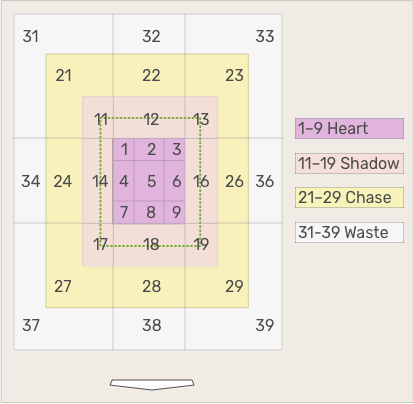
Now, I admit that this may not be the perfect way to do this, but I’m going to show you how I decided to go about all of this.
To see where Heaney’s sinker plays best, I split up in the zones into three of my own zones: up (11-13 and 21-23), middle (14, 16, 24, 26), and down (17-19 and 27-29). You will notice that I excluded the “heart” of the plate (zones 1-9). Given that it’s a sinker, we would expect it to play best down, and for it to get thrashed when pitched up.
Here’s what I found for xwOBA from 2018-2019, by location:
- Up: .165 xwOBA
- Middle: .366 xwOBA
- Down: .384 xwOBA
You’re probably surprised. Given the information I’ve presented, you should be surprised. The only reason I wasn’t is that I had a working hypothesis going into this exercise: Heaney’s sinker has elite spin rate—it’s in the 96th percentile. As we have come to find out, pitchers have a high spin on their fastballs tend to have the greatest success at the top of the zone because, to the naked eye, high spin fastballs appear to defy gravity and “rise.” I’ve written about this a ton lately, and I suppose I’ve found myself getting into it again here.
Here’s his sinker in action against Elvis Andrus:
https://gfycat.com/admiredultimateambushbug
He elevates his sinker, and Andrus flails at it. Heaney’s sinker doesn’t look much like your typical sinker. Most notably, it, uh, doesn’t sink—it has the rise of a four-seam fastball. That makes it a fly-ball pitch, which is very unusual for a sinker. This is why his average launch angle on sinkers this season is 33 degrees, and why his fly-ball and pop-up percentages on his sinker have jumped up to 42.3% and 23.1%, respectively.
Here’s a better angle of an elevated sinker, versus Marwin Gonzalez:
https://gfycat.com/fickledescriptivegroundhog
To be clear, that is not a typical sinker. This angle does a great job of exemplifying that it’s missing the most common characteristics of a sinker: sink (duh), and arm-side run. This one has rise.
You may find it interesting, then, that Heaney doesn’t elevate all that often. Here is Heaney’s sinker location since 2018:
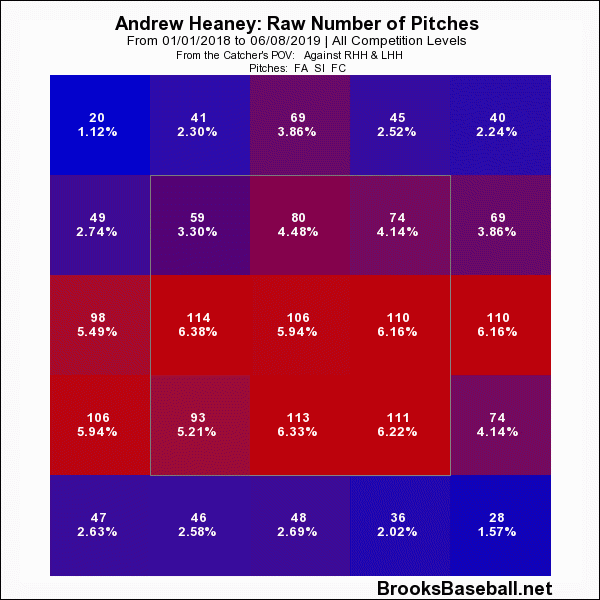
And here is Heaney’s whiff rate on his sinker, since 2018:
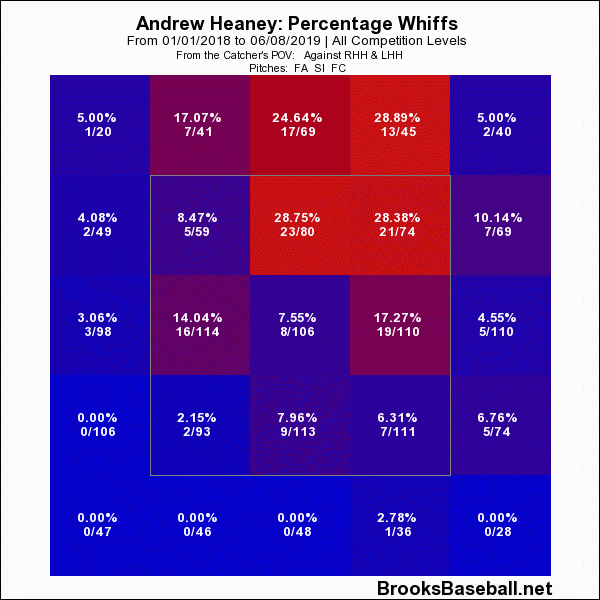
There’s some incongruence between the two graphics, right? Heaney gets whiffs at the top of the zone, but the majority of his pitches come in the middle of the zone or lower. Well, it seems like it’s something Heaney is working on.
Sinker location, 2018 versus 2019:
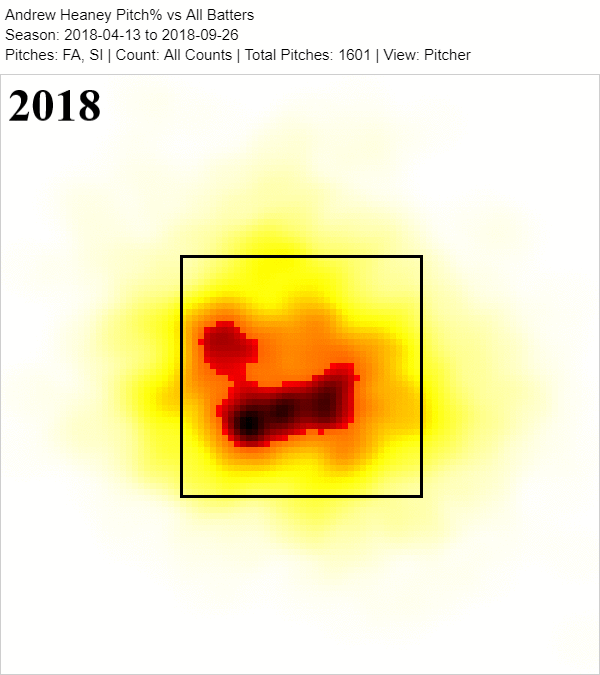
The ball is still over the heart of the plate much more than I’d prefer, but Heaney is moving in the right direction. The sample size isn’t huge, but it’s not small.
If this isn’t compelling, here’s Heaney’s average vertical sinker location, by year:
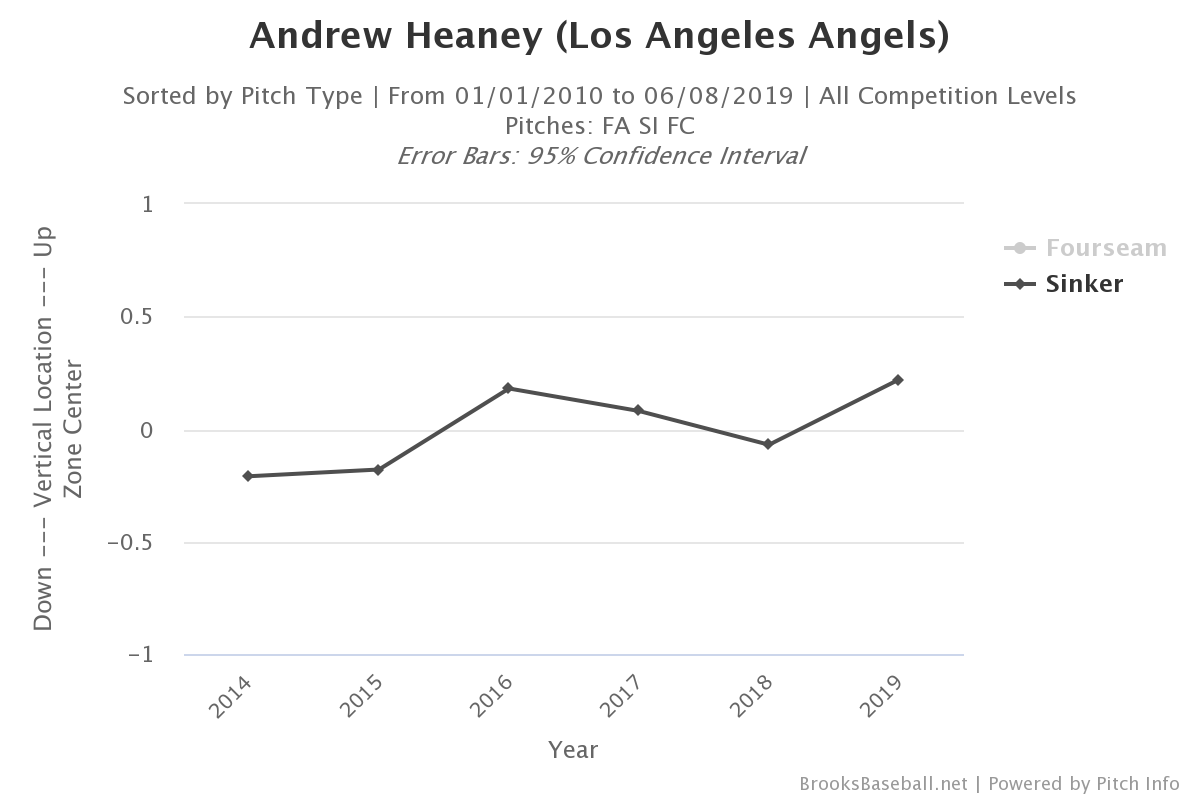
As you can see, Heaney has toyed with the idea of elevating his sinker before, but that was in 2016. Additionally, the two years in which Heaney has a sizable sample size are the years where he’s pitched down in the zone the most with his sinker (i.e., 2015 and 2018).
As shown above, Heaney is still pitching over the plate a fair amount. To me, there’s no need for this. Heaney has shown a penchant to paint the corners when he wants, his fastball gets great rise, and the middle of the plate is where he’s gotten into trouble. Four of his six home runs have come off of his sinker, after all.
Here, Heaney’s sinker leaks over the plate too much:
https://gfycat.com/creativehighdiplodocus
And here, Heaney completely misses his spot:
https://gfycat.com/hoarsedesertedbuckeyebutterfly
If you ask me, the other two home runs he gave up on his sinker weren’t so bad.
First, against Tom Murphy:
https://gfycat.com/selfassuredaridgenet
Against Murphy you may argue, in hindsight, that this is the exact pitch he was looking for. Murphy’s got a fly-ball percentage of 50.0% and pull-percentage of 54.3%, so to me, this was more of an error in plan than execution (although that’s likely not where he wanted to put his sinker). In an 0-2 count, I’m going curveball out of the zone, and if we’re still going fastball, it’s up out of the zone. Nevertheless, the ball did leak over the plate more than he intended, and the expected batting average on this ball is just .324.
Then there’s Hunter Pence:
https://gfycat.com/welltodogeneroushornedviper
To his credit, Pence is having a great year, and this pitch is on the outer edge of the plate. Pence pokes it into right field over the fence. The expected batting average is, again, only .390. So while he did seem to miss his spot for the fourth time, this would have been an out in a lot of parks.
His sinker is incredibly important, as it’s the pitch to set up both of his secondaries—he’s thrown it more than 50% of the time every year of his career, and 65.1% thus far in 2019. At his best, Heaney’s sinker should set up his curveball and changeup, and, in return, they should help his sinker play up. Symbiosis, baby!
I’ve plotted three of Heaney’s most effective games from 2018:
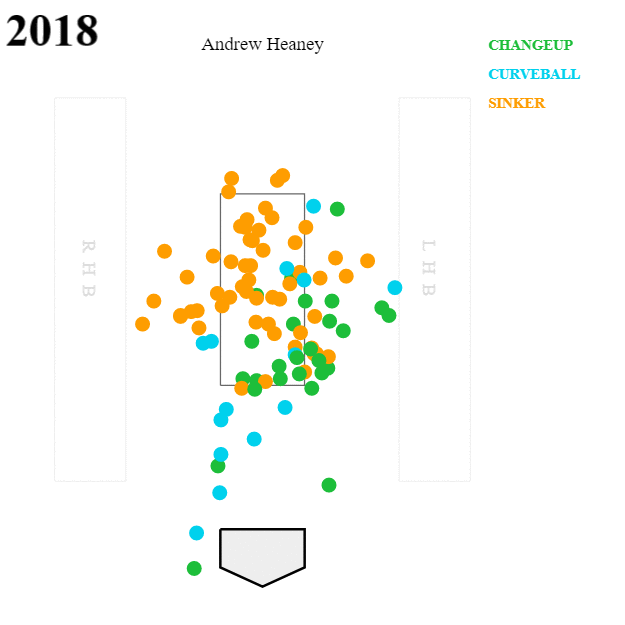
In the graphic above, I want you to focus on where he’s locating his fastball and changeup. We’ll come back to this shortly.
Next, I’ve plotted all three of Heaney’s games from 2019:
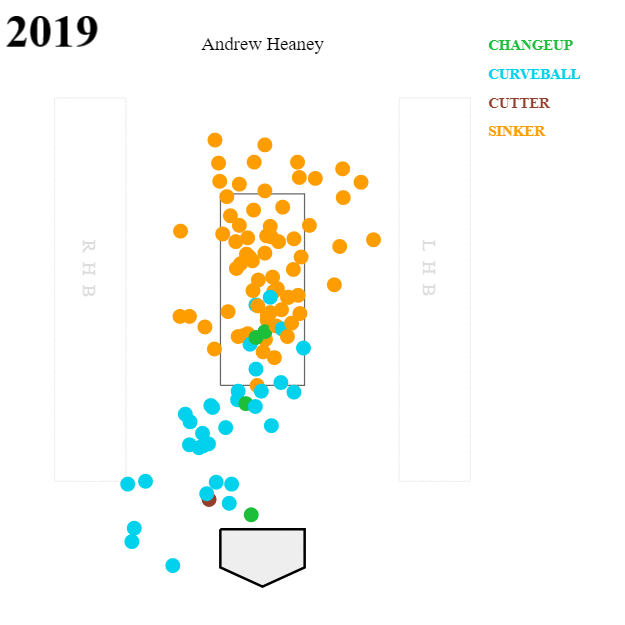
Now, I know it’s difficult to scroll up and down to scan between the differences both between pictures in the graphics and between the graphics themselves. I’ll make it easier for you by putting it into a bulleted list:
2018:
- Fantastic changeup location
- Good curveball location, mostly
- Fastballs towards the edges more than middle
- Fastballs middle to down in the zone
2019:
- Elevated fastballs
- Fastballs over the “heart” more than last year
- Amazing curveball location
- Clear cutoff between hard and breaking pitches
- Where’s the changeup?
I want to avoid confirmation bias here, because sometimes the eye sees what it wants to see. Going back to Baseball Savant’s attack zone graphic: In 2019, Heaney has thrown 25.7% of his sinkers in the “heart” zone. In 2018, though, he threw in the “heart” zone 17.8% of the time. With statistics, we often have an idea of what’s good and what’s bad, but here, I admit it’s difficult to know how big of a difference 25.7% and 17.8% are, so I’ll put it into perspective: In 2018, Heaney was in the 52nd percentile in fastballs thrown over the heart of the plate. In 2019, Heaney is in the 97th percentile.
Some pitchers can be more effective here than others—Emilio Pagan, who I wrote about last week, has a .207 xwOBA on the year on heaters in the “heart” zone. Heaney does not—his xwOBA on his fastball “heart” pitches is .448. That’s nearly Felix Hernandez and Mike Leake level of mediocrity, so Heaney needs to either stay away from the middle of the plate or complement his sinker better with his other pitches. Why not both?
We haven’t talked about his curveball or changeup yet, but I’ll preface by saying that they’re both great. First, let me introduce you to his curveball. This is a pitch that, besides letting the forces of gravity act on it, doesn’t actually do that much in the way of movement.
From Alex Chamberlain’s PITCHf/x database, Heaney’s 2017 curveball, denoted by the yellow arrow:

It’s truly fascinating. It barely gets any movement, but it’s wildly effective. I’ll throw some numbers at you in a second, but first, let’s watch Heaney embarrass Mallex Smith with his curveball:
First pitch:
https://gfycat.com/ordinarygorgeouscrossbill
The 0-1 pitch:
https://gfycat.com/presentlegitimatecrownofthornsstarfish
The 0-2 punchout:
https://gfycat.com/carelessspiffyatlanticridleyturtle
In this at-bat, Heaney never has to pitch in the zone, and he doesn’t ever go to his sinker. Granted, Smith had seen his sinker earlier on in the game, but this was the second time this game that Smith struck out swinging on a Heaney curveball in the dirt. You can see how, as a hitter, it’s an alluring pitch.
It’s not a fluke, either. His career zone-percentage for his curveball is 26.7%, and it’s down to 19.8% this year. Heaney truly does this all the time—and it’s effective. Over his career, he’s induced a 43.7% outside-swing percentage and generated a 22.2% swinging-strike rate. When this pitch is out of the zone, hitters have no chance.
As for his changeup, by pVAL, it’s been his best pitch over his career, and it was his best pitch in 2018. Towards the end of last year, it was one of the best changeups in the league. More recently, he’s lost his command of it.
Here’s what his changeup looks like, at its best:
Look at Andrew Heaney’s changeup location yesterday in his 12 K performance against the Chicago White Sox.
It’s been missing for a good a while and this is as gorgeous as it gets. pic.twitter.com/1GDV53NHwU
— Pitcher List (@PitcherList) September 10, 2018
And here’s what it’s looked like, this year:

Clearly, he has no feel for it right now. Since returning from the injured list, he’s only thrown it 13 times—that’s less than once per inning. If you’ve seen him pitch in 2019, he’s trying to incorporate it, but you can tell that it’s not going where he wants it to.
His changeup is a pitch that he uses exclusively against right-handed hitters, but it’s a valuable weapon for him. In keeping it low and away from righties, Heaney is able to mix it in to get easy strikes and induce weak ground balls. This year, Heaney has gotten considerably worse against righties by expected slugging-percentage, fly-ball percentage, and ground-ball percentage. That’s a function of (a) his changeup not contributing to his overall ground-ball percentage, since he doesn’t have it, and (b) hitters only having to watch for his sinker and curveball. His sinker, because of its high spin, is a fly-ball pitch. This all helps to contextualize his average launch angle, the rise in fly-ball percentage, and the home runs. Those should level out eventually, though. (His 27.3% HR/FB is just not going to persist.)
Overall, Heaney has been inspiring. It’s easy to gawk at the ERA and home runs, but at the end of the day, this is only 16.1 innings, and Heaney is in the 76th percentile in xwOBA—that’s better than Marcus Stroman, Kyle Hendricks, and Mike Minor. There’s been some misfortune at play here, and there are current issues that will not continue to be problematic—the disappearance of his changeup, for instance.
It’s a little amazing if you think about it. Heaney has leaned on just two pitches—his sinker and curveball—for 95.1% of his pitches. That’s Tyler Glasnow status. The thing is, if everything goes right, Heaney will have a changeup that he’ll be able to lean on with his other offerings. It’s hard enough to tout two plus pitches, but if you ask me, Heaney could be wielding three.
There’s not much left here to adjust. If the sinker continues to elevate and avoid the middle of the plate and we see the changeup come back, we have the makings of a Matthew Boyd or Caleb Smith—and if you squint a little, there’s some Blake Snell in there as well. If you’re Andrew Heaney’s changeup and you’re out there reading this—please come back. You’re one of few things stopping Heaney from achieving ace-dom.
(Photo by Brian Rothmuller/Icon Sportswire)


These going-deep articles are one of the many reasons this site is a cut above the rest. I actually just swapped Shin-Soo Choo for Heaney just yesterday. I’m hoping it pays off.
Thanks Joey! That’s the goal, so that means a lot. Choo for Heaney sounds great!
Great article, Mikey. I can only imagine the number of open tabs, screenshots, and back n forth clicks you go threw writing these as you confirm your theories lol.
I think another huge problem with those home runs you highlighted from Heaney are the lack of awareness of hitter tendencies. I can give some credit to Pence for letting that ball get deep for sure, but he goes the other way well and was just green lit for a fastball anywhere in that plane. I would’ve tried either freezing him with a curveball or caving out of the zone. Best case, back in the count; worst case, one guy goes to 1st and you deal with the next. Middle-third fastballs in bases-empty 3-0 counts make me want to scream lol.
The Choo HR was a clear missed spot and bad pitch, but for Santana and Murphy, you gotta know better than to come into the zone with an 0-2 heater against big swingers. I agree the execution to Murphy wasn’t all that bad, but still, you gotta know the type of hitter you’re facing. I think as Heaney starts getting a bit more refined in understanding who’s standing at the dish and adjusting to the tendencies certain types of hitters have in certain counts, these skills that you covered are going to allow him to thrive even more. Sky’s the limit.
Nice job, bud.
‘Preciate it Dan! And yes, I do an awful lot of back and forth clicking during these articles.
Totally agree on the hitter tendencies part. I do think that if Heaney got his pitches exactly where he wanted that none of them would have resulted in home runs, but I would agree that I’d like to see him try a curveball or sinker up out of the zone (that feels so weird to say) first.